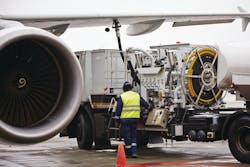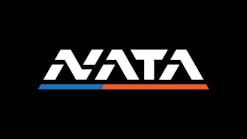How To Conduct Safe Aircraft Refuel Servicing Operations
Flashpoint is defined as "the temperature at which a particular organic compound gives off sufficient vapor to ignite in air." For example, gasoline will ignite and burn at -45°F. The flashpoint of standard aviation gas (AVGAS) is 46°C (−50°F), Jet B can be as low as −23°C (−10°F), and Jet A has been calculated at a minimum of 38°C (100°F), about the same as diesel fuel.
With flash and ignition temperatures at levels this low, it becomes a matter of utmost importance to ensure that all aircraft fueling and fuel services are carried out in accordance with the highest standard of safety.
The National Fire Protection Association is an organization dedicated to reducing the burden of fire and other hazards to life safety by providing consensus codes and standards, research, and education. It is this organization that has set the standard for fire protection and life safety for aircraft fuel servicing operations in their document, NFPA 407, Standard for Aircraft Fuel Servicing.
BEST WAY
Many times as we go through our workday in our respective careers we wonder why we do things the way we do. And we wonder if we are doing things right, or the "best way". This brief introduction and overview of the operations section of NFPA 407 will enlighten you as to why fueling operations are conducted as they are, and serve as a guideline to ensure that your operation is performing these operations in a safe, and code compliant manner.
NFPA 407, Chapter 5 outlines the required safe operational practices during fuel operations.
- The foremost requirement is that only properly trained personnel are permitted to conduct fueling operations.
Besides being trained on the proper use of fueling equipment, operators must also be trained on the operation of emergency controls and the actions to be taken in the event of an emergency. All training records should be maintained and made available to the local fire official (commonly referred to as the AHJ, authority having jurisdiction) when requested.
- Fuel vehicles shall be marked.
This standard requires both sides of the fuel vehicle to be marked with the name of the operator or responsible organization. Other standards also mandate the fuel trucks be properly placarded with type of fuel and associated hazard.
- If a spill should occur the following procedures should be followed: activate the emergency fuel shutoff, notify supervisor, initiate clean-up by trained personnel only. If the spill is greater than 10’ or more than 50 feet squared or presents an immediate hazard, the airport fire rescue crews should be notified to respond.
- The integrity of the emergency fuel shutoff system shall be maintained at all times.
There shall always be a clear access path to these devices. This standard requires that the emergency fuel shutoff systems be functionally tested every 6 months, and each device tested annually. These tests and any deficiencies shall be documented and associated records retained.
- When passing through pumps, piping, and filters of a fuel system aviation gas and Jet A fuels create an electrostatic charge. To prevent spark and possible ignition, the fuel equipment shall be bonded to the aircraft.
The bonding cable shall be attached prior to, and throughout, the fueling operation. When fueling is complete, the bonding cable shall be removed in the reverse order from which it was applied (it was placed first, it should be detached last).
- Special notice should be given to the position of other vehicles around the aircraft prior to beginning the fueling process.
Internal combustion engine vehicles should not be permitted within 50 feet of the aircraft being fueled. The vehicle performing fueling operations is not to be positioned within 10 feet of the aircraft fuel vent system.
- The use of electrical equipment on the servicing ramp during fueling shall be prohibited.
This includes battery chargers, connecting/disconnecting of ground power generators, power tools, photographic equipment, and communications devices. Additionally, any connected ground power units should be positioned as far as possible from fueling points and tank vents.
- It should be obvious but, the lack of stating the obvious is what most often leads to mishaps and fire incidents, no open flame devices are permitted onto the fuel servicing ramp.
This should be accomplished by the posting of "No Smoking" signage, and the prohibiting of personnel from carrying lighters and matches on their person.
- The aircraft to be fueled is to be positioned so that it is no closer than 25 feet to a hangar, service building, termina, or loading area.
The fuel vehicle operator should pay attention to the positioning of his vehicle, in relation to the location of the aircraft, to ensure that accessibility for emergency crew access is maintained. Also, the fuel vehicle operator should ensure that he has a clear path of egress for himself if an emergency should occur.
- A minimum of two fire extinguishers are required on each fueling vehicle.
They each must be rated at 20-B:C (this rating will be stated on the extinguishers label), and one should be mounted on each side of the vehicle. If the capacity of the fuel system is greater than 200 gpm then an additional 80-B:C wheeled extinguisher is required at the fueling site.
All fire extinguishers must be visible and readily accessible. Fire extinguishers are required to be inspected monthly (this can be done by assigned facility personnel). This inspection is looking for a few basic things: is the extinguisher in its proper location, is the pressure gauge in the green (if not, it needs to be serviced), is the extinguisher in good condition and free of visible defects.
Furthermore, every extinguisher is required to be inspected and tagged annually by a licensed fire extinguisher technician. These inspections must be documented and available for the AHJ upon request. The use of fire extinguishers is a required component of the fuel servicing personnel training program.
For further information refer to NFPA 10, Standard for Portable Fire Extinguishers which details all the requirements for fire extinguishers (type, size, location, maintenance, servicing, and use).
- All fuel servicing equipment must be maintained in good working condition.
The only way to tell that equipment is still in its proper useable condition is to provide regular inspection, testing, and maintenance of the various system components.
The most important component of the fuel system is the hose itself. This should be inspected daily. Inspection of the hose should be conducted by extending it out to normal use length, and looking for any evidence of blistering, cuts, or nicks.The couplings should be examined for slippage, misalignment, or leaks.
At least monthly, the hose is to be extended for its full length and inspected for damage as previously stated. In addition, the nozzle screens should be examined for pieces of rubber which is an indication of interior deterioration. The hose should then be tested at working pressure, any twisting or ballooning indicates weakness.
If any of these issues are noticed the hose should be taken out of service.
Fuel servicing carts and vehicles should be neat and clean. Grease, oil, and other combustibles shall not be present on the vehicle. If any leaks are spotted, the vehicle should be taken out of service, until repairs can be made. A minimum of 10 feet between parked vehicles shall be maintained to allow for fire protection and control purposes.
The effects of a fire incident, no matter the size, can be far reaching. Fire effects organizations in five ways: Economically, a fire can result in loss of jobs or loss of contracts. Organizationally, a fire contributes added cost to the business operations. Legally, civil litigation and lost time can ensue. Psychologically, employees and customers are subjected to a traumatic experience. Politically, the company can lose community support.
By following these guidelines laid out in NFPA 407, Standard for Aircraft Fuel Servicing, loss from fire can be prevented, and life safety of employees and customers maintained.
This brief overview should give you a good place to start to ensure that your facility is on the path to full compliance and a safe operation. Utilize the operations safety self-evaluation to determine your areas of strength, weakness, and greatest need.All referenced codes and standards are available for free, as read-only, from http://www.nfpa.org/codes-and-standards/document-information-pages


